#optimise for Google Maps
Explore tagged Tumblr posts
Text
Local SEO for Small Businesses: Everything You Need to Know
Master Local SEO and get your business found by local customers. From Google Business Profile optimisation to local keyword strategies, reviews, and citations, boost your local visibility and grow your business. Contact Koobr today to strengthen your Local SEO presence and dominate your market.
#local SEO UK#small business SEO#Google Business Profile optimisation#local keyword research#local citations UK#local link building#mobile-friendly website SEO#local SEO mistakes to avoid#local SEO for service businesses#optimise for Google Maps#Koobr
0 notes
Text
User Intent Optimization is the process of aligning your content with the specific needs and expectations of users. Search engines like Google prioritize delivering results that match user intent, making it essential for businesses to focus on intent-driven SEO.
#digitalpreeyam#search engine optimization#content optimization#content marketing#what is search intent in 2025#what is search intent in seo#what is search intent in hindi 2025#what is search intent in seo 2025#user engagement optimization#search intent in hindi 2025#search intent in search engine optimisation.#how to rank higher in google maps#search intent optimization#search engine ranking factors 2025#google ranking optimization#ai content optimization
0 notes
Text
Le Guide Ultime pour devenir Planificateur(rice) de Voyages
Chers passionnés de voyages et professionnels du tourisme, nous avons récemment publié un article détaillé sur notre Masterclass Travel Planner. Vous y découvrirez les coulisses de la planification de voyages, des astuces pour une expérience au top!
Comprendre le rôle d’un planificateur de voyage Métier.Les tâches principales d’un planificateur de voyage comprennent :Développez vos compétences en planification de voyage.Choisissez votre créneau et spécialisez-vous.Voici quelques exemples de créneaux que vous pouvez choisir pour vous spécialiser en tant que planificateur de voyage :Commercialisez-vous et développez votre entreprise.Voici…

Voir sur WordPress
#Budget voyage formation#Cours spécialisé tourisme#CRM tourisme#Formation tourisme avancée#Gestion budgétaire voyage#Gestion clientèle voyage#Gestion de la clientèle tourisme#Gestion de la communication voyage#Google Maps itinéraire voyage#Hootsuite gestion réseaux sociaux#Intelligence artificielle tourisme#Masterclass tourisme#Meilleure formation voyage#Optimisation budget voyage#Outils planification voyage#Outils Travel Planner#Planification budget voyage#Planification itinéraire formation#Planification voyage professionnelle#Rendez-vous formation Travel Planner#Slack communication professionnelle#Stratégies communication digitale voyage#Techniques planification voyage#Travel Planner formation#Trello gestion voyage
0 notes
Text
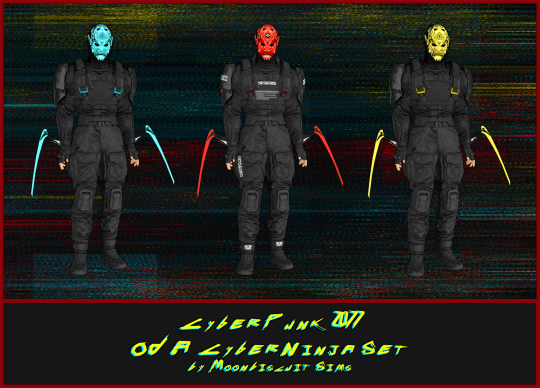
Cyberpunk 2077 - Oda Cyber-Ninja Set (Sims 4 cc)
This set includes the following Cyberpunk 2077 Conversions: 🐱👤 Oda's mask with light emission (hat category):
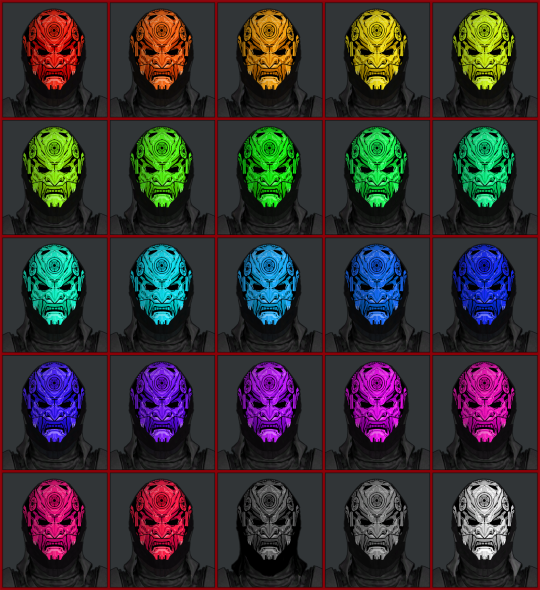

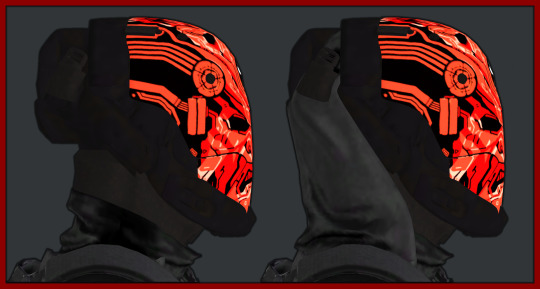

2 variations with and without hood. One is Oda's mask with Arasaka logo with glowing red emission. The other is a plain cyber-ninja mask with no logo and with white light emission in all colours (I couldn't have different coloured emissions in one package so chose white as neutral for the glow). The without hood one is for if you wanna use it with a different or no top, the hood one is only for the jacket version since it looks weird on its own.
🐱👤Oda's Outfit:
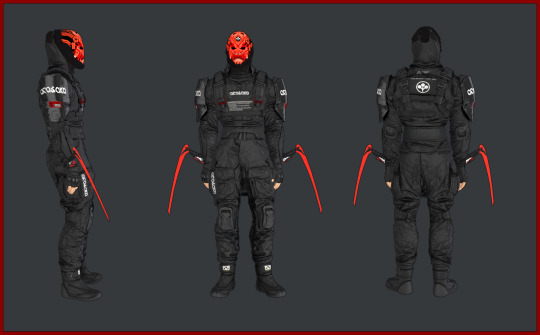
🐱👤Oda's Cyber-ninja jacket (jacket category):
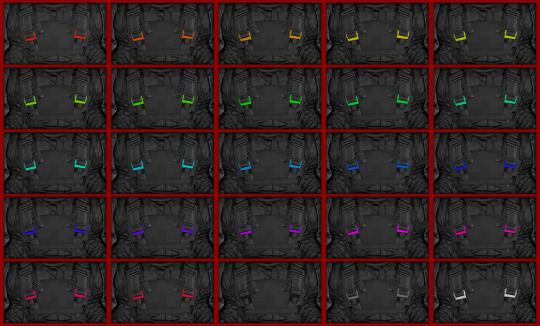
Includes a swatch with all the logos for Oda, and then a lot of plain no logo swatches with coloured buckle detail in all colours. 🐱👤Oda's Cyber-ninja pants + shoes (see above picture, pants category): 2 swatches, with logos and plain. The shoes are attached to the pants 🐱👤Addon recolour of @hamsterbellbelle 's mantis blades (left bracelet category)


Oda's one has arasaka logo (you can't see with the jacket) glows red and all the colours that glow white, matching the mask and the jacket. The glows are synced. I got explicit permission by hamster to modify the uvs for some things (just so the arasaka logo on oda's one is not backwards lol), but I cloned their package/mesh, so please download the original too to not cause any issues like it missing. I don't know it it requires it or not since I made changes but thank you @hamsterbellbelle o(〃^▽^〃)o 🐱👤DOWNLOAD HAMSTERBELLBELLES BLADES
🐱👤Info, and Issues: -Has normal and specular maps. - Pants are a bit stretching weird between the legs, I couldn't fix it. You see it when sim separates the legs. I think I accidentally merged it somewhere during the process. Sorry - Blurry logos (not all just some). I didn't have any uv space left, and I don't know how to do transparent decal meshes for cas. So i just put them in the texture image and therefore they're a bit blurry on areas where the texture was small. - Textures are hq but I don't play with that mods so no idea if it made a difference. - HIGH POLY, especially the clothing and the jacket. Be mindful of use if you have a crusty laptop that struggles with sims 4 :( I tried my best to optimise the mesh but it is just a very complex outfit and that is after deleting tons of details and things. In my game it runs fine, so hopefully should be ok. - The hood version doesn't perfectly align with jacket where the fabric connected, since I made the hood a separate hat, but you can't tell much. - Cloned package for helmet from Battuu for emission to work, but it shouldn't require this pack since I imported all Lods and textures. I tested without the pack and it appears. However it won't appear if you use the filters, so just find it in the menu with no filters. Any issues or it doesn't show up pls tell me. - weird distortion on buckles on jacket, I tried fixing weights and such but couldn't fix this little bit, it's very small. - Don't forget mesh for the mantis blades and check out hamsters stuff :) one does not play cyberpunk on sims without it 🐱👤PLEASE READ AND RESPECT MY CC TERMS OF USE: - DO NOT REUPLOAD - DO NOT PUT BEHIND PAYWALL OF ANY KIND - DO NOT INCLUDE CC IN ANY DOWNLOADS (link to my download) - DONT CLAIM YOU MADE IT 🐱👤If you would like to consider supporting my work, you can donate to my PATREON , all content is free, but donating would really help me create more

🐱👤DOWNLOAD GOOGLE DRIVE 🐱👤DOWNLOAD PATREON There's a merged file, don't download both merged and separated or you'll have duplicates.
‼‼‼AND REMEMBER!!!! WATCH THE DISTANCE; HE WILL SLICE YOU LIKE FISH!!! 🍣YOU WILL BRING DEATH TO YOUR DOOR 🐱👤 🐱👤 🐱👤
#moonbiscuitsims#moonbiscuitsims4#moonbiscuitsimscc#moonbiscuitsimscyberpunk#moonbiscuitsimscas#the sims 4#ts4#sims 4#ts4 simblr#cyberpunk#cyberpunk 2077#sims 4 cyberpunk#sims 4 cyberpunk cc#cyberpunk sims#sandayu oda#cyberpunk oda#oda cyberpunk#cyberninja#cp2077#cyberpunk2077#cp77
47 notes
·
View notes
Text
Resamatic

Resamatic – Agence SEO locale à Toulouse & Agence de marketing à Toulouse spécialisée en SEO local
Vous recherchez une Agence SEO locale à Toulouse pour apparaître dans le Top 3 Google Maps et attirer plus de clients près de chez vous ? Bienvenue chez Resamatic, votre agence de marketing à Toulouse experte en SEO local à Toulouse, dédiée aux TPE, artisans, commerçants et indépendants de la région toulousaine.
Nous aidons les professionnels locaux à générer plus d’appels, de rendez-vous et de ventes grâce à une stratégie simple, concrète et 100 % orientée résultats.
Nos services phares en SEO local à Toulouse :
Optimisation de votre fiche Google Business Profile (anciennement Google My Business) pour booster votre position dans les résultats locaux et apparaître sur la carte.
Création de tunnel de conversion local pour capter les clients qui trouvent votre entreprise sur Google.
Automatisation des avis clients : demande, réponse et publication gérées automatiquement.
Création de contenu local optimisé SEO : Google Posts, FAQ, photos, descriptions, tout est pensé pour convaincre dès le premier clic.
Audit SEO local gratuit et suivi personnalisé pour mesurer vos résultats.
Pourquoi choisir notre agence SEO locale à Toulouse ?
Agence locale et indépendante, implantée à Toulouse.
Résultats visibles rapidement : +93 % d’appels entrants en moyenne dès les 30 premiers jours.
Service clé en main : vous ne vous occupez de rien, on s’occupe de tout.
Tarifs accessibles : Plan Express dès 19,95 €, formule complète jusqu’à 1 500 €.
Zones d’intervention :
Toulouse, Blagnac, Colomiers, Tournefeuille, Balma, L’Union, Ramonville, Saint-Orens, Muret, Cugnaux…
📢 Votre fiche Google est votre nouvelle vitrine. Confiez-la à une agence marketing à Toulouse qui connaît réellement le terrain local.
📞 Prenez rendez-vous pour un audit gratuit et découvrez tout ce que notre expertise en SEO local à Toulouse peut apporter à votre entreprise.
Contactez-nous
Resamatic
10-12 Port Saint-Sauveur, Toulouse, 31400, France
+33 5 54 54 0035
https://resamatic.com/local/agence-seo-toulouse/
Trouvez-nous en ligne
Facebook
Instagram
Tiktok
Youtube
Connectez-vous avec nous
Cylex
Hotfrog
Cybo
Brownbook
Startus
Pour en savoir plus
Resamatic GMB
Agence SEO locale à Toulouse Site
Agence SEO locale à Toulouse Map
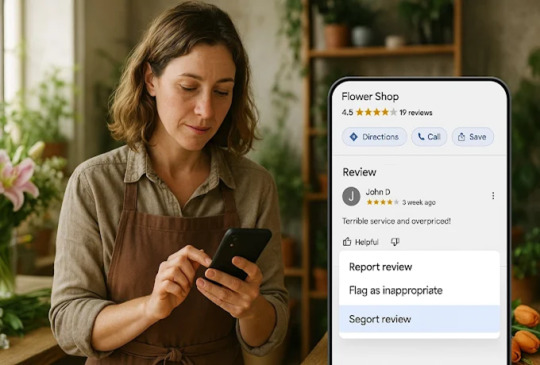
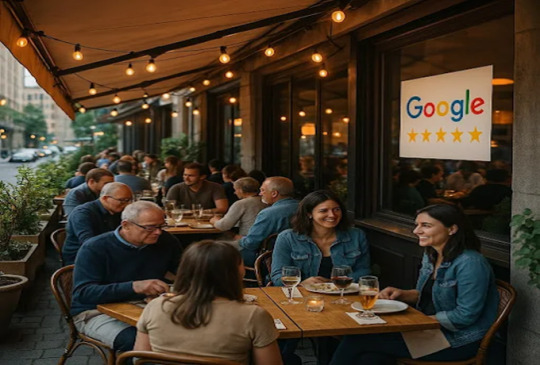
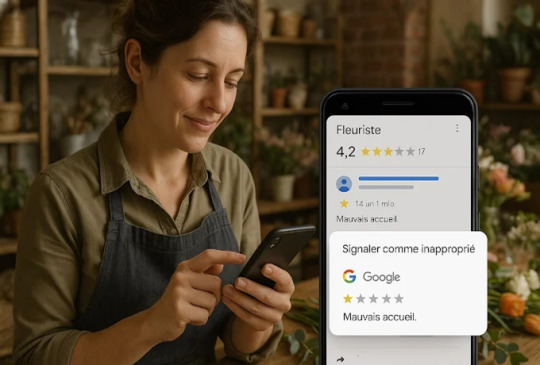
2 notes
·
View notes
Text
3 notes
·
View notes
Text
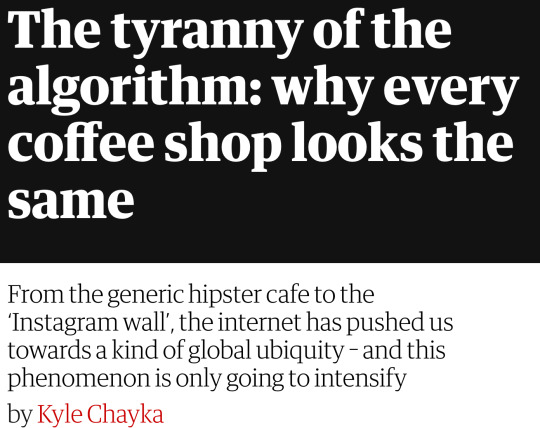
The tyranny of the algorithm: why every coffee shop looks the same (Kyle Chayka, The Guardian, Jan 16 2024)
"These cafes had all adopted similar aesthetics and offered similar menus, but they hadn’t been forced to do so by a corporate parent, the way a chain like Starbucks replicated itself.
Instead, despite their vast geographical separation and total independence from each other, the cafes had all drifted toward the same end point.
The sheer expanse of sameness was too shocking and new to be boring.
Of course, there have been examples of such cultural globalisation going back as far as recorded civilisation.
But the 21st-century generic cafes were remarkable in the specificity of their matching details, as well as the sense that each had emerged organically from its location.
They were proud local efforts that were often described as “authentic”, an adjective that I was also guilty of overusing.
When travelling, I always wanted to find somewhere “authentic” to have a drink or eat a meal.
If these places were all so similar, though, what were they authentic to, exactly?
What I concluded was that they were all authentically connected to the new network of digital geography, wired together in real time by social networks.
They were authentic to the internet, particularly the 2010s internet of algorithmic feeds. (…)
My theory was that all the physical places interconnected by apps had a way of resembling one another.
In the case of the cafes, the growth of Instagram gave international cafe owners and baristas a way to follow one another in real time and gradually, via algorithmic recommendations, begin consuming the same kinds of content.
One cafe owner’s personal taste would drift toward what the rest of them liked, too, eventually coalescing.
On the customer side, Yelp, Foursquare and Google Maps drove people like me – who could also follow the popular coffee aesthetics on Instagram – toward cafes that conformed with what they wanted to see by putting them at the top of searches or highlighting them on a map.
To court the large demographic of customers moulded by the internet, more cafes adopted the aesthetics that already dominated on the platforms.
Adapting to the norm wasn’t just following trends but making a business decision, one that the consumers rewarded.
When a cafe was visually pleasing enough, customers felt encouraged to post it on their own Instagram in turn as a lifestyle brag, which provided free social media advertising and attracted new customers.
Thus the cycle of aesthetic optimisation and homogenisation continued."
15 notes
·
View notes
Text
riemann spheres as a fundamental type, pt.1 basics
ive been thinking on and off about riemann spheres for a while now, a couple weeks really, and so far i think there's some utility to them as a building block of a type system of some kind for a joke/toy computer language
background: riemann spheres are a neat tool in complex analysis where we imagine a sphere whose equator intersects the complex plane, and every number on the complex plane is representable by a point on the sphere such that a line is projected from the north pole and through that point onto the complex plane. naturally, this means that the north pole is P(∞) and the south pole is P(0). see below how that would look like with other unit points of the complex numbers
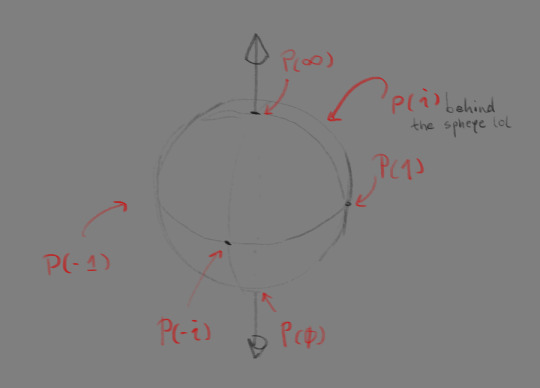
a neat thing the riemann sphere allows us is to define meaningful division by zero so now z/0 = ∞ clean and simple! and also its inverse, z/∞ = 0 is well behaved as well. this simplifies doing complex analysis but stereographic projection is an absolute bitch to work with turns out, and doing arithmetic on points on the sphere is a mess because it's not a linear mapping (it's continuous though so that's fine)
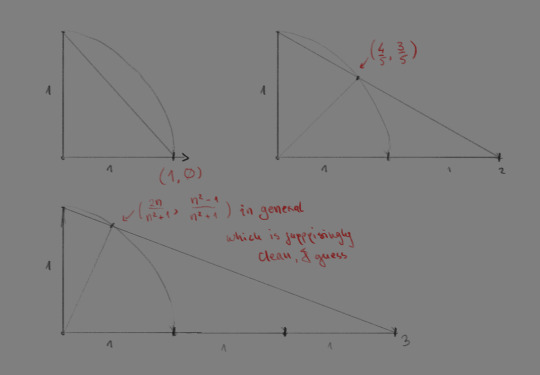
if we're dealing with ONLY real numbers in relation to a circular slice of the riemann sphere, it already starts looking like a mess; for any number n∈R its projective cognate on the circle is located at (2n/n²+1, n²-1/n²+1). on the real riemann sphere though? zoo wee mamma
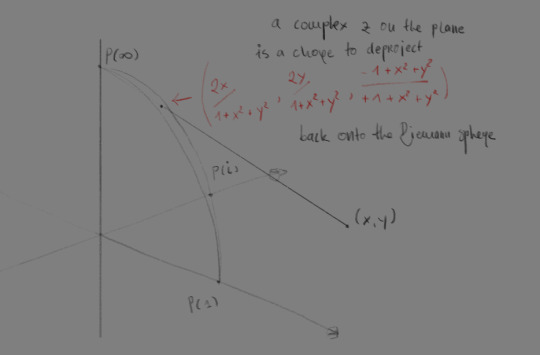
an arbitrary z∈C, represented as a point (x,y) on the complex plane, has to walk through a rather ugly mapping (related to the previous one) to find its point on the sphere; more accurately, given the coordinates (x,y) of the point on the plane, the point on the sphere is located at (2x/1+x²+y², 2y/1+x²+y², -1+x²+y²/1+x²+y²), which is godawful in spherical-to-polar coordinate terms, this is much simpler; for a polar pair (r,θ) the point on the unit sphere representing it is (φ,ξ) = (2*arctg 1/r, θ); and conversely projecting from the riemann sphere is also dead simple, given the zenith-azimuth pair (φ,ξ), (r,θ) = (ctg φ/2, ξ). of course, translating from polar to real coordinates is ALSO dead simple; x = r * cos θ, y = r * sin θ. if a computer system were to store complex numbers (or any coordinate on a 2d plane really), it makes sense to store them in terms of spherical coordinates of a riemann sphere, since this makes infinity well-behaved as a unit (zenith = 0, azimuth = literally who gives a fuck) and is surprisingly efficient. knowing that the zenith is ∈[0,π] and azimuth ∈[0, 2π] can allow for some formidably dumb optimisations that can save on space and ensure granularity. compared to storing them as 2d cartesian or polar coordinates, this provides the benefit of having neither number be larger than like 6.3, so an underlying/backing type that can offer great precision in this small range would be more efficient numerically than, say, floating points which have insane baggage and gaps
or iunno i'll look into that one a bit later, i'm just kind of furious right now that i rederived stereographic projection on my own when the formulas were right fucking there if id only just googled for them
#rambling#math#maths#mathematics#riemann sphere#stereographic projection#complex analysis#trigonometry#complex plane#complex numbers
5 notes
·
View notes
Text
Intel VTune Profiler For Data Parallel Python Applications
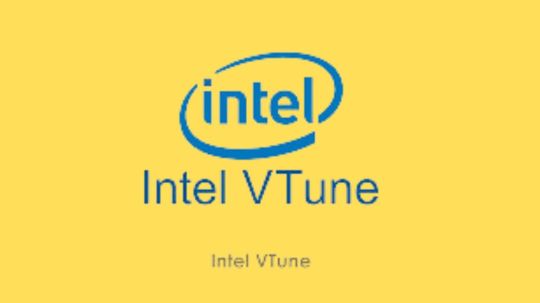
Intel VTune Profiler tutorial
This brief tutorial will show you how to use Intel VTune Profiler to profile the performance of a Python application using the NumPy and Numba example applications.
Analysing Performance in Applications and Systems
For HPC, cloud, IoT, media, storage, and other applications, Intel VTune Profiler optimises system performance, application performance, and system configuration.
Optimise the performance of the entire application not just the accelerated part using the CPU, GPU, and FPGA.
Profile SYCL, C, C++, C#, Fortran, OpenCL code, Python, Google Go, Java,.NET, Assembly, or any combination of languages can be multilingual.
Application or System: Obtain detailed results mapped to source code or coarse-grained system data for a longer time period.
Power: Maximise efficiency without resorting to thermal or power-related throttling.
VTune platform profiler
It has following Features.
Optimisation of Algorithms
Find your code’s “hot spots,” or the sections that take the longest.
Use Flame Graph to see hot code routes and the amount of time spent in each function and with its callees.
Bottlenecks in Microarchitecture and Memory
Use microarchitecture exploration analysis to pinpoint the major hardware problems affecting your application’s performance.
Identify memory-access-related concerns, such as cache misses and difficulty with high bandwidth.
Inductors and XPUs
Improve data transfers and GPU offload schema for SYCL, OpenCL, Microsoft DirectX, or OpenMP offload code. Determine which GPU kernels take the longest to optimise further.
Examine GPU-bound programs for inefficient kernel algorithms or microarchitectural restrictions that may be causing performance problems.
Examine FPGA utilisation and the interactions between CPU and FPGA.
Technical summary: Determine the most time-consuming operations that are executing on the neural processing unit (NPU) and learn how much data is exchanged between the NPU and DDR memory.
In parallelism
Check the threading efficiency of the code. Determine which threading problems are affecting performance.
Examine compute-intensive or throughput HPC programs to determine how well they utilise memory, vectorisation, and the CPU.
Interface and Platform
Find the points in I/O-intensive applications where performance is stalled. Examine the hardware’s ability to handle I/O traffic produced by integrated accelerators or external PCIe devices.
Use System Overview to get a detailed overview of short-term workloads.
Multiple Nodes
Describe the performance characteristics of workloads involving OpenMP and large-scale message passing interfaces (MPI).
Determine any scalability problems and receive suggestions for a thorough investigation.
Intel VTune Profiler
To improve Python performance while using Intel systems, install and utilise the Intel Distribution for Python and Data Parallel Extensions for Python with your applications.
Configure your Python-using VTune Profiler setup.
To find performance issues and areas for improvement, profile three distinct Python application implementations. The pairwise distance calculation algorithm commonly used in machine learning and data analytics will be demonstrated in this article using the NumPy example.
The following packages are used by the three distinct implementations.
Numpy Optimised for Intel
NumPy’s Data Parallel Extension
Extensions for Numba on GPU with Data Parallelism
Python’s NumPy and Data Parallel Extension
By providing optimised heterogeneous computing, Intel Distribution for Python and Intel Data Parallel Extension for Python offer a fantastic and straightforward approach to develop high-performance machine learning (ML) and scientific applications.
Added to the Python Intel Distribution is:
Scalability on PCs, powerful servers, and laptops utilising every CPU core available.
Assistance with the most recent Intel CPU instruction sets.
Accelerating core numerical and machine learning packages with libraries such as the Intel oneAPI Math Kernel Library (oneMKL) and Intel oneAPI Data Analytics Library (oneDAL) allows for near-native performance.
Tools for optimising Python code into instructions with more productivity.
Important Python bindings to help your Python project integrate Intel native tools more easily.
Three core packages make up the Data Parallel Extensions for Python:
The NumPy Data Parallel Extensions (dpnp)
Data Parallel Extensions for Numba, aka numba_dpex
Tensor data structure support, device selection, data allocation on devices, and user-defined data parallel extensions for Python are all provided by the dpctl (Data Parallel Control library).
It is best to obtain insights with comprehensive source code level analysis into compute and memory bottlenecks in order to promptly identify and resolve unanticipated performance difficulties in Machine Learning (ML), Artificial Intelligence (��AI), and other scientific workloads. This may be done with Python-based ML and AI programs as well as C/C++ code using Intel VTune Profiler. The methods for profiling these kinds of Python apps are the main topic of this paper.
Using highly optimised Intel Optimised Numpy and Data Parallel Extension for Python libraries, developers can replace the source lines causing performance loss with the help of Intel VTune Profiler, a sophisticated tool.
Setting up and Installing
1. Install Intel Distribution for Python
2. Create a Python Virtual Environment
python -m venv pyenv
pyenv\Scripts\activate
3. Install Python packages
pip install numpy
pip install dpnp
pip install numba
pip install numba-dpex
pip install pyitt
Make Use of Reference Configuration
The hardware and software components used for the reference example code we use are:
Software Components:
dpnp 0.14.0+189.gfcddad2474
mkl-fft 1.3.8
mkl-random 1.2.4
mkl-service 2.4.0
mkl-umath 0.1.1
numba 0.59.0
numba-dpex 0.21.4
numpy 1.26.4
pyitt 1.1.0
Operating System:
Linux, Ubuntu 22.04.3 LTS
CPU:
Intel Xeon Platinum 8480+
GPU:
Intel Data Center GPU Max 1550
The Example Application for NumPy
Intel will demonstrate how to use Intel VTune Profiler and its Intel Instrumentation and Tracing Technology (ITT) API to optimise a NumPy application step-by-step. The pairwise distance application, a well-liked approach in fields including biology, high performance computing (HPC), machine learning, and geographic data analytics, will be used in this article.
Summary
The three stages of optimisation that we will discuss in this post are summarised as follows:
Step 1: Examining the Intel Optimised Numpy Pairwise Distance Implementation: Here, we’ll attempt to comprehend the obstacles affecting the NumPy implementation’s performance.
Step 2: Profiling Data Parallel Extension for Pairwise Distance NumPy Implementation: We intend to examine the implementation and see whether there is a performance disparity.
Step 3: Profiling Data Parallel Extension for Pairwise Distance Implementation on Numba GPU: Analysing the numba-dpex implementation’s GPU performance
Boost Your Python NumPy Application
Intel has shown how to quickly discover compute and memory bottlenecks in a Python application using Intel VTune Profiler.
Intel VTune Profiler aids in identifying bottlenecks’ root causes and strategies for enhancing application performance.
It can assist in mapping the main bottleneck jobs to the source code/assembly level and displaying the related CPU/GPU time.
Even more comprehensive, developer-friendly profiling results can be obtained by using the Instrumentation and Tracing API (ITT APIs).
Read more on govindhtech.com
#Intel#IntelVTuneProfiler#Python#CPU#GPU#FPGA#Intelsystems#machinelearning#oneMKL#news#technews#technology#technologynews#technologytrends#govindhtech
2 notes
·
View notes
Text
Submitted via Google Form:
I made a rough map but then after assigning how much time it takes people to get around with various transports and prices and alternatives as well as trying to make it make sense and not just have transport because. However I've found lots of plot holes and started editing things but one edit makes the rest of the map go awry. So I made a more detailed map so sometimes I don't need to edit the entire thing. But now things are spiralling and I have a massive map with hundreds of points and extreme details that get even more screwed up as I make changes. Uhh. What do I do? Timing and optimising ideal times/budgets to get to places, etc is an important part of the character's actions and plot points.
Tex: The fantastic thing about maps is that you can have more than one of them, each suited to a different subject regarding the same area. A master map with all of the data points that you want is very useful, and will allow you to extract specific information for maps about more focused subjects (i.e. geographical features vs settlements vs train lines vs climate zones vs botanical). This is helpful in that on individual, subject-specific maps, you can coordinate colour keys in order to generate an overall scheme, such as which colours you prefer for greater vs lower densities, or background vs foreground information.
The Wikipedia page on maps contains a lot of useful information in this regard, and I would also recommend making a written outline of the information that you have on your map, in order to organize the information displayed there, keep track of changes, and plan how to group your information.
Licorice: It sounds as if you’re having difficulty deciding whether your map should dictate your plot, or vice versa. If your story were set on Earth, your map would be fixed, and the means of transport would be, to some extent, dictated to you; you’d only have to decide where your characters should go next - Beijing, or New York?
I’m getting the impression that with this story, you’re creating the map and devising the plot simultaneously, and what you’ve ended up with is a map that’s so detailed it has become inconsistent and difficult even for its own creator to make sense of. It sounds as if the map is becoming an obstacle to writing the story rather than an aid to it. At the same time, though, it sounds like you have a much clearer idea of your plot points and where this story is going than you did when you started.
Maybe it’s time to put the map aside and focus on writing the story? Then when you’re done, update the map so it’s fully in line with the story you’ve written.
Alternatively, put the story aside for a moment, draft a new simplified map using everything you’ve learnt about your story so far, and then treat it like something as fixed as a map of Earth - something to which additional details can be added, but nothing can be changed.
I found on tumblr this chart of the daily distances a person can travel using different modes of transport, which may be useful to you:
Realistic Travel Chart
Good luck! Your project sounds fascinating.
Mod Note: I’ll toss in our two previous map masterposts here for reader reference as well
Mapmaking Part 1
Mapmaking Part 2 Mapping Cities and Towns
18 notes
·
View notes
Text
Le Guide Ultime pour devenir Planificateur(rice) de Voyages
Chers passionnés de voyages et professionnels du tourisme, nous avons récemment publié un article détaillé sur notre Masterclass Travel Planner. Vous y découvrirez les coulisses de la planification de voyages, des astuces pour une expérience au top!
Comprendre le rôle d’un planificateur de voyage Métier.Les tâches principales d’un planificateur de voyage comprennent :Développez vos compétences en planification de voyage.Choisissez votre créneau et spécialisez-vous.Voici quelques exemples de créneaux que vous pouvez choisir pour vous spécialiser en tant que planificateur de voyage :Commercialisez-vous et développez votre entreprise.Voici…

View On WordPress
#Budget voyage formation#Cours spécialisé tourisme#CRM tourisme#Formation tourisme avancée#Gestion budgétaire voyage#Gestion clientèle voyage#Gestion de la clientèle tourisme#Gestion de la communication voyage#Google Maps itinéraire voyage#Hootsuite gestion réseaux sociaux#Intelligence artificielle tourisme#Masterclass tourisme#Meilleure formation voyage#Optimisation budget voyage#Outils planification voyage#Outils Travel Planner#Planification budget voyage#Planification itinéraire formation#Planification voyage professionnelle#Rendez-vous formation Travel Planner#Slack communication professionnelle#Stratégies communication digitale voyage#Techniques planification voyage#Travel Planner formation#Trello gestion voyage
0 notes
Text
The 12 Most Important SEO Steps for Solving Low Visibility
Introduction
A strong online presence is critical for the success of any organization in the digital age, where online competition is tough. Even with a well-designed website and great content, many businesses struggle with their search engine presence. This is where Search Engine Optimization (SEO) enters the picture. Businesses may improve their website's rating on search engine results pages (SERPs) and increase their online visibility by applying the correct methods. In this blog post, we'll look at the 12 most crucial SEO procedures for resolving low visibility concerns and putting your website back on the map.
Conduct a Thorough Website Assessment:
Conducting a thorough website assessment is the first step in resolving poor visibility concerns. To find areas for improvement, use technologies such as Google Analytics and Google Search Console. Examine the overall performance of the site, look for broken links, guarantee correct indexing, and evaluate loading speed.
Conduct Keyword Research:
The core of SEO is keywords. Investigate relevant keywords and phrases used by your target audience to look for items or services in your niche. Use keyword research tools like Google Keyword Planner and SEMrush to uncover high-volume, low-competition keywords for your content.
Optimize On-Page Content:
After you've found your target keywords, optimize your on-page content. Create high-quality, entertaining, and instructive material that naturally incorporates the chosen keywords. To make your material more search engine friendly, pay attention to meta titles, meta descriptions, heading tags, and URL structures.
Improve the User Experience (UX):
Google places a high value on the user experience. Make sure your website is mobile-friendly, easy to use, and visually appealing. A good user experience encourages visitors to stay on your site longer, lowering bounce rates and enhancing search rankings.
Build High-Quality Backlinks:
Earning backlinks from respectable and relevant websites can dramatically increase the authority and visibility of your website. Concentrate on producing useful content that other websites will want to link to. Build a solid backlink profile by collaborating with influencers, partners, and industry leaders.
Local SEO should be optimised:
Local SEO is critical if your company services a specific geographical area. Claim your Google My Business listing and give the correct business information, such as your address, phone number, and hours of operation. Encourage customers to post favourable reviews, as they can help you rank higher in local searches.
Utilize the Power of Social Media:
Social media platforms influence SEO in addition to engagement. Share your material on multiple social media platforms to boost your reach and the possibility of obtaining backlinks. Engage your audience and cultivate a loyal following, which can help you rank higher in search results.
Increase the speed with which your website loads:
A website that takes too long to load can result in higher bounce rates and lower search rankings. To improve the speed of your website, optimize images, employ browser caching, and use content delivery networks (CDNs).
Optimizing for Voice Search:
With the rise of voice assistants such as Siri and Alexa, optimizing for voice search has become critical. Long-tail keywords and natural language phrases should be used in your content to match how visitors express their queries.
Apply Schema Markup:
Schema markup assists search engines in better understanding your content and displaying rich snippets in search results. This can result in increased click-through rates and visibility. To successfully deploy schema markup, use Google's Structured Data Markup Helper.
Update and refresh the content on a regular basis:
Keep your website fresh and current by periodically updating and revising your content. Add new blog posts, modify old ones, and make sure your content is relevant and up to date.
Evaluate and Analyze Performance:
SEO is an ongoing activity, and it is critical to routinely evaluate the performance of your website. Track your search rankings, organic traffic, and other important metrics using analytics tools. Adjust your SEO strategy as necessary to maintain your visibility.
Conclusion:
Solving low visibility concerns with SEO is a comprehensive process that demands commitment, perseverance, and a well-rounded strategy. You can overcome low visibility challenges and establish a strong online presence by conducting a website audit, performing keyword research, optimizing content, and focusing on user experience, backlinks, local SEO, social media, loading speed, voice search, schema markup, content updates, and performance analysis.
Read More :
4 notes
·
View notes
Text
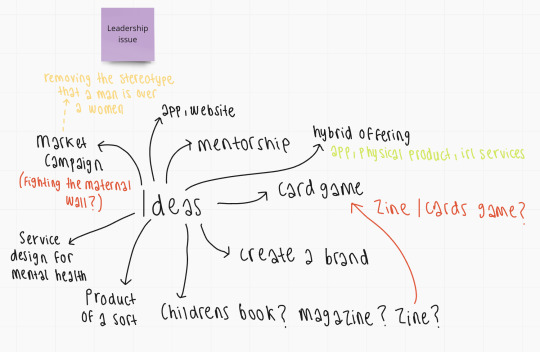
DES 302 - Week 2 Capstone
#302week2 of capstone! And so the grind begins!
It seems last week was still half-holiday mode but now the real work kicks off! Last week I revisited my research proposal and reminded myself of the case studies that I gathered. I have quickly understood that in this semester organisation is key to 301 and 302. Thus I created various timelines and to-do lists for all my courses (including how I will implement my design methodology in which weeks). Something I am concerned with this semester is that I will technically be taking a five-paper semester (DES301+302 and INTBUS202). However, it seems so far that this international business paper is on a lighter load in terms of work.
For context, I am a student in the Business/DEI stream. And, my how might we statement looks at “How might we design through the lens of DEI, for maternal women in the corporate environment”. This comes from my views and concerns when entering the workforce. As well as, circumstances my own family have dealt with. That being said, nearing the end of last week is when my precedents and mood boarding began for this project. At this point in time I have no firm idea of what I want the end result to be. However, I feel I may head in the direction of creating a non-profit organisation that offers perhaps a mixture of products/services. There will be a strong focus on all aspects of the DEI framework. And, this is how I mapped this concept:
//IDEA//
1. Non-profit organisation = a brand
2. Fundraising scheme = a workshop? / selling products?
3. An app that holds all this information
4. A market campaign to boost awareness (titled: the maternal wall)
The two outputs I am pretty keen to develop are creating a brand (non-profit organisation) and a market campaign. This is due to my passion for marketing, as well as my understanding that there is a stereotype towards maternal women in the workforce. I want to navigate this understanding and provoke viewers of this said marketing campaign to act and think differently towards what the ‘perception’ of maternal women is. With the information I have gathered, I am excited to begin this part of the project.
So far, the tool I am utilising the most is Miro and Google. These two are working very well hand-in-hand in terms of optimising my searchability and organisational skills. However, I look forward to using tools such as adobe (illustrator and photoshop are my go-to). As well as, perhaps challenging myself to use 3D software such as Maya or Blender - and then figma if delving into UX/UI.
As I embark on this semester-long project I am fearful of the long nights and challenges ahead. I understand this will not be a smooth-running roadmap, and some weeks will turn to shambles. However, I am hopeful with consistency and better organisation, I will be able to manage any nightmares that await! I am also anxious about the feedback I will be asking for during this week in terms of my ideas thus far - ideally, I get given the green light on my ideas otherwise if not I will find it difficult to look towards other outputs.
3 notes
·
View notes
Text

🎉 Introducing our unbeatable deal: Get a stunning WordPress website developed for just Rs. 4999/-! 🔥 With over 20+ amazing features included, your website will stand out from the crowd. Plus, enjoy the added bonus of FREE hosting for 1 years!
It will include:
✅ Theme installation and Setup
✅ WhatsApp plugin
✅ Live chat plugin
✅ Inquiry from
✅ Complete content placement
✅ Website optimized logo
✅ Website optimisation
✅ Social media Integration
✅ SEO Plugins
✅ Footer Layout
✅ Web App Optimized
✅ Graphic and images placement
✅ Youtube video embedding
✅ Responsive Website
✅ Gallery view
✅ Google map location
✅ Pop up form
✅ Facebook Pixel tracking *
✅ Google analytics tracking
✅ Hubspot Form
✅ Reviews and testimonials
✅ Favicon Integration
Don't miss this chance to establish your online presence with a professional, feature-rich website. Act now and let us bring your digital dreams to life! 💻🌐
Contact Us Today:
9503321001
www.aciwebsolution.com
#digital marketing#email marketing#searchengineoptimization#online marketing#seo expert#seo company#seotips#social media marketing#seo marketing#webdevelopment
2 notes
·
View notes
Text
SEO for Neural Search & AI Assistants: The Next Evolution of Digital Discovery
Welcome to the new era of search, where machines don’t just read keywords, they comprehend intent. This is the rise of neural search and AI assistants, where search engines behave more like humans than ever before.
Traditional SEO techniques now face a formidable challenge. Keywords alone are no longer enough. Algorithms now crave context, tone, emotion, and semantics. If you’re still stuffing phrases and counting backlinks, you’re walking backwards on a bullet train.
In this new landscape, AI assistants like ChatGPT, Google Assistant, Alexa, and Siri now dictate user decisions. Neural networks that power search engines think in layers, just like our brains. The future is not about ranking pages. It’s about becoming the voice that answers questions before they’re asked.
So, let’s see what SEO expert in Melbourne are up to. First things first—
What Is Neural Search?
Neural search uses artificial neural networks to simulate how humans process language. These systems can infer meaning from phrases, decode intent, and evaluate context with uncanny precision. Forget matching “cheap red shoes” to exact-match web pages. Neural search understands that “affordable crimson sneakers” means the same thing.
Algorithms like Google’s BERT, MUM, and OpenAI’s GPT have revolutionised search. They don’t just retrieve—they interpret. These models can translate feelings into search results. They can read between the lines and even predict follow-up questions.
In this model, search is no longer a hunt for words. It’s a quest for relevance.
Enter the AI Assistant: Search’s New Gatekeeper
AI assistants have become the go-to interface for information seekers. People no longer open browsers. They simply speak in full sentences and get clear, conversational responses from AI assistants.
This changes everything. SEO must now adapt to voice-first, conversational ecosystems. There’s no top ten list. There’s only one winner—the answer that gets spoken aloud. To dominate AI-driven search, your content must become that answer.
The Vanishing Keyword Era
Old-school SEO was keyword-centric. You picked phrases and crammed them in titles and alt tags. But neural search sees through that charade.
Today, Google knows that “how do I fix a leaky faucet” is connected to “plumbing DIY tips” and “stop kitchen sink dripping.” Synonyms, sentence structure, and even emotional tone all contribute to meaning.
Keywords still matter—but only as guides. They are no longer the destination. Think themes, entities, and natural language.
Writing for Machines That Think Like Humans
To win in neural search, write like you’re explaining something to a curious, intelligent friend. Ditch robotic structures and embrace fluidity. Use complete thoughts, infuse emotion, and be specific.
AI doesn’t just scan words. It scans behaviour now. It looks for intentional alignment. It means your content must match not only what users say, but also why they say it.
Here’s a practical trick: start with the end user’s problem, then build backwards. Use semantically rich language. Weave in context. Don’t just provide an answer—deliver insight.
Structured Data: Give Machines a Map
Neural search thrives on clarity. You can boost clarity by using structured data. Schema markup turns chaotic content into understandable blocks. It helps machines categorise, cross-reference, and elevate your answers.
Want to be the spoken response from Alexa? Mark up your FAQs. Want your product details to show in Google Shopping? Use product schema. The more signals you provide, the more searchable your content becomes.
Conversational Optimisation: The Art of Flow
AI assistants are conversational, which means your content must be, too. What does it mean, you wonder? Optimise for the rhythm of speech. Create content that sounds good when read aloud. Use shorter sentences and transitional phrases. Repeat keywords naturally, like a human would.
Questions are crucial. Include common queries as subheadings. Answer directly. Follow up with elaboration. This simulates the way AI assistants respond in layers.
Here’s a sample flow:
What is neural search?
How does it change SEO?
What can I do to optimise for it?
Each question leads to the next. Each answer builds trust.
E-E-A-T is More Important Than Ever
Expertise. Experience. Authoritativeness. Trustworthiness.
Google’s E-E-A-T framework gains momentum in the age of AI. Neural networks reward clarity, credibility, and consistency.
Cite reliable sources.
Add author bios.
Show experience.
Share case studies.
Use facts, not fluff.
If you want to be the chosen voice in this new world, you must build digital authority like never before.
Mobile and Multimodal Optimisation
Voice search is mostly mobile, so your site must be lightning-fast, responsive, and seamless. AI also favours multimodal content—images, audio, video, and text that blend together.
Use video transcripts.
Include captions.
Add alt text to images.
Optimise podcasts with show notes.
Your content should be versatile enough to live anywhere—on screens, in smart speakers, or through augmented lenses.
The Importance of Topical Authority
One-off blog posts won’t cut it. You need content ecosystems. That means building entire clusters around core themes. Don’t write a single post about “neural search.” Create a pillar and link it to articles on semantic indexing, structured data, and voice optimisation.
Topical authority tells neural engines that you know your domain. It tells assistants that your site isn’t just a content mill—it’s a knowledge source.
The Rise of Zero-Click Results
Neural search favours instant answers. People ask, and machines respond. No clicks needed. That’s terrifying for traffic, but golden for branding. If you can own the answer, you own the moment. Here’s how you do it:
Use bullet points.
Create one-sentence summaries.
Insert key information at the top.
Treat every paragraph like a tweetable insight.
Overall, your content must be succinct, structured, and satisfying.
Conclusion
The world of search has mutated, and the rules have shifted. No longer do we optimise just for Google. We optimise for algorithms that mimic human cognition. We write not only for screens, but for smart speakers, glasses, and AI bots.
If you’re still treating SEO as a formula, you’re behind. Get in touch with Make My Website, Melbourne’s best SEO expert, to get your digital game transformed.
0 notes
Text
Web Development for Local Businesses: Optimising for Hyperlocal SEO
For local businesses, visibility in your immediate area isn’t just helpful—it’s essential. Whether you're a neighbourhood café, boutique, or home repair service, your customers are searching for you on Google Maps and local listings. That’s where hyperlocal SEO comes in—ensuring your website speaks directly to nearby audiences and appears at the top of local searches.
A seasoned Web Development Company understands that great design and clean code are only part of the picture. To drive real foot traffic and local leads, your site must be built with hyperlocal SEO in mind from day one. Here's how expert agencies tailor web development to boost your local search presence.
1. Building Location-Focused Site Architecture
Local SEO begins with structure. Instead of a one-size-fits-all site, development teams create architecture that reflects physical geography. For single-location businesses, that means ensuring your NAP (Name, Address, Phone number) is consistent and crawlable across your site.
For multi-location businesses, web developers create individual landing pages for each branch—structured like:
bashCopy
Edit
example.com/locations/andheri example.com/locations/koramangala
Each page is optimized for local keywords, meta tags, and schema to ensure visibility in local search and Google’s “near me” results.
2. Implementing Local Schema Markup
Search engines rely on structured data to display rich results. Agencies use localBusiness schema markup to help Google understand:
Your exact business type (e.g., restaurant, hair salon, law firm)
Operating hours
Street address and postal code
Geo-coordinates
Customer ratings
This microdata doesn’t appear on your website visually, but it dramatically improves your chances of showing up in local search packs and maps.
3. Geo-Targeted Keywords in Content and Code
Hyperlocal SEO isn’t just about inserting your city’s name a few times. It’s about using precise keywords that match how people search in their area:
“Best vegan bakery in Whitefield”
“Emergency plumber near Andheri East”
“Affordable preschool Koramangala”
Web development agencies ensure that these keywords are naturally integrated into:
Page titles and H1 tags
Meta descriptions and alt attributes
Internal link anchors and URLs
Dynamic location selectors for users and search bots alike
This layered approach helps your site signal strong location relevance to Google.
4. Mobile-First, Speed-Optimized Design
Most hyperlocal searches happen on mobile—often when the user is on the move. A slow or clunky site could mean a lost lead. That’s why local business websites must be:
Responsive: Adapting seamlessly across screen sizes
Fast-loading: Lightweight CSS, lazy-loaded images, CDN integration
Tappable: Click-to-call, quick booking buttons, map integrations
Professional developers prioritize Core Web Vitals to make sure your mobile experience meets Google’s standards for speed, interactivity, and stability.
5. Google Business Profile Integration
Your Google Business Profile (GBP) is one of the most powerful assets in hyperlocal SEO. While it exists outside your website, your site must support and reinforce it. Agencies ensure:
Your NAP matches exactly across both platforms
Your site links to the GBP and vice versa
Local reviews are showcased on the site using APIs or plug-ins
Structured data aligns with GBP categories
This tight integration reinforces credibility and helps your profile rank higher in Google’s local map results.
6. Local Reviews and Testimonials Page
Customer reviews don’t just influence buyers—they’re also a ranking factor. Agencies often build:
Dedicated testimonials pages with location-based filters
Review widgets that pull in latest feedback from Google or Yelp
Schema-enhanced star ratings that appear in search results
This gives your website social proof while increasing local keyword density and structured data coverage.
7. Integration with Hyperlocal Marketing Tools
Beyond SEO, local business websites benefit from integration with tools like:
WhatsApp or Facebook Messenger for instant chat
Geo-fencing ad platforms
Local delivery APIs
Zip code-based service area selectors
A capable development team ensures these features work smoothly and don’t bloat performance.
Conclusion
In the age of "near me" searches, your digital storefront needs more than good looks—it needs to be locally relevant, fast, and optimized for discovery. A Web Development Company that understands hyperlocal SEO can help your business appear in the right searches, at the right time, to the right audience.
Whether you’re targeting a single street or scaling across neighbourhoods, the right web development strategy ensures that local customers don’t just find you—they choose you.
0 notes